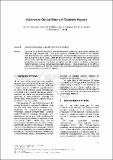Files in this item
Advances in optical sensing of explosive vapours
Item metadata
| dc.contributor.author | Gillanders, Ross Neil | |
| dc.contributor.author | Samuel, Ifor David William | |
| dc.contributor.author | Turnbull, Graham Alexander | |
| dc.contributor.author | Campbell, Iain Angus | |
| dc.contributor.author | Glackin, James Michael Edward | |
| dc.contributor.editor | Raposo, Maria | |
| dc.contributor.editor | Ribeiro, Paulo A. | |
| dc.date.accessioned | 2018-03-06T10:30:11Z | |
| dc.date.available | 2018-03-06T10:30:11Z | |
| dc.date.issued | 2018-01-25 | |
| dc.identifier | 252066165 | |
| dc.identifier | 4842ffe9-33f1-46e0-9133-62fe101b114c | |
| dc.identifier | 85052017239 | |
| dc.identifier.citation | Gillanders , R N , Samuel , I D W , Turnbull , G A , Campbell , I A & Glackin , J M E 2018 , Advances in optical sensing of explosive vapours . in M Raposo & P A Ribeiro (eds) , Proceedings of the 6th International Conference on Photonics, Optics and Laser Technology (PHOTOPTICS 2018) . SciTePress , pp. 323-327 , Photoptics 2018 , Madeira , Portugal , 25/01/18 . https://doi.org/10.5220/0006729403230327 | en |
| dc.identifier.citation | conference | en |
| dc.identifier.isbn | 9789897582868 | |
| dc.identifier.isbn | 9789897582868 | |
| dc.identifier.other | ORCID: /0000-0002-8825-3234/work/40797750 | |
| dc.identifier.uri | https://hdl.handle.net/10023/12856 | |
| dc.description | This project has received funding from the European Union’s Seventh Framework Programme for research, technological development and demonstration under agreement no 284747, and the EPSRC under EP/K503940/1, EP/K503162/1, and EP/N509759/1. IDWS acknowledges a Royal Society Wolfson Research Merit Award. | en |
| dc.description.abstract | Optical techniques for the detection of explosives are receiving increasing interest due to potentially fast responding, highly-sensitive systems. Conjugated polymers are suitable probe materials for this application since their fluorescence is quenched by electronegative materials including explosives. This can be used to make a sensor for explosive vapour, which can then give chemical information to help identify explosive devices, and complements other approaches such as metal detectors and ground penetrating radar. Whilst the principle has been known for some time, its practical implementation requires considerable development of instrumentation and materials, including preconcentration materials. This paper reports our current efforts to address these challenges, with particular emphasis on humanitarian demining and looking towards application in Improvised Explosive Device (IED) detection. | |
| dc.format.extent | 304544 | |
| dc.language.iso | eng | |
| dc.publisher | SciTePress | |
| dc.relation.ispartof | Proceedings of the 6th International Conference on Photonics, Optics and Laser Technology (PHOTOPTICS 2018) | en |
| dc.subject | Organic semiconductors | en |
| dc.subject | Conjugated polymers | en |
| dc.subject | Instrumentation | en |
| dc.subject | QC Physics | en |
| dc.subject | T Technology | en |
| dc.subject | NS | en |
| dc.subject.lcc | QC | en |
| dc.subject.lcc | T | en |
| dc.title | Advances in optical sensing of explosive vapours | en |
| dc.type | Conference item | en |
| dc.contributor.sponsor | European Commission | en |
| dc.contributor.sponsor | The Royal Society | en |
| dc.contributor.institution | University of St Andrews. School of Physics and Astronomy | en |
| dc.contributor.institution | University of St Andrews. Condensed Matter Physics | en |
| dc.identifier.doi | https://doi.org/10.5220/0006729403230327 | |
| dc.identifier.grantnumber | en | |
| dc.identifier.grantnumber | en |
This item appears in the following Collection(s)
Items in the St Andrews Research Repository are protected by copyright, with all rights reserved, unless otherwise indicated.

